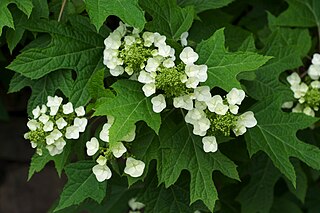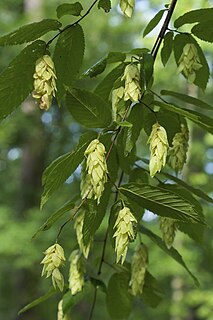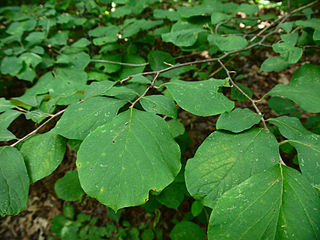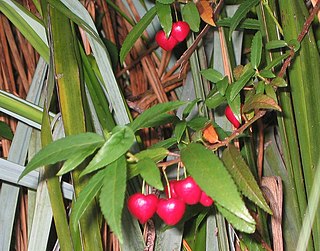
Hydrangea quercifolia, commonly known as oakleaf hydrangea or oak-leaved hydrangea, is a species of flowering plant in the family Hydrangeaceae. It is native to the southeastern United States, in woodland habitats from North Carolina west to Tennessee, and south to Florida and Louisiana. A deciduous shrub with white showy flower heads, it is a commonly grown garden plant. Numerous cultivars are available commercially.

Carpinus caroliniana, the American hornbeam, is a small hardwood tree in the genus Carpinus. American hornbeam is also known as blue-beech, and musclewood. It is native to eastern North America, from Minnesota and southern Ontario east to Maine, and south to eastern Texas and northern Florida. It also grows in Canada.

Quercus imbricaria, the shingle oak, is a deciduous tree in the red oak group of oaks. It is native primarily to the Midwestern and Upper South regions of North America, from southern New York west to northern Illinois and eastern Kansas, and south to central Alabama and Arkansas. It is most commonly found growing in uplands with good drainage, less often along lowland streams, at 100–700 m altitude.

Ribes sanguineum, the flowering currant, redflower currant, red-flowering currant, or red currant is a North American species of flowering plant in the family Grossulariaceae, native to western United States and Canada, but widely cultivated and naturalized throughout temperate Europe and Australasia.

Quercus dentata, also called Japanese emperor oak or daimyo oak is a species of oak native to East Asia. The name of the tree is often translated as "sweet oak" in English to distinguish it from Western varieties.

Vasconcellea candicans is a small tree native to the western slopes of the Andes in southern Ecuador and Peru.

Ostrya virginiana, the American hophornbeam, is a species of Ostrya native to eastern North America, from Nova Scotia west to southern Manitoba and eastern Wyoming, southeast to northern Florida and southwest to eastern Texas. Populations from Mexico and Central America are also regarded as the same species, although some authors prefer to separate them as a distinct species, Ostrya guatemalensis. Other names include eastern hophornbeam, hardhack, ironwood, and leverwood.
The elm cultivar Ulmus 'Myrtifolia', the Myrtle-leaved Elm, first appeared in nursery and horticultural lists from the 1830s, as Ulmus myrtifolia and Ulmus campestris myrtifolia, the name Ulmus myrtifoliaVolxem being used at Kew Gardens from 1880. Lawson's nursery of Edinburgh appears to have been the earliest to list the tree. 'Myrtifolia' was listed by Nicholson in Kew Hand-List Trees & Shrubs (1896), but without description. It was later listed as a cultivar and described by Rehder in 1939 and by Krüssmann in 1962.

Ipomoea indica is a species of flowering plant in the family Convolvulaceae, known by several common names, including blue morning glory, oceanblue morning glory, koali awa, and blue dawn flower. It bears heart-shaped or 3-lobed leaves and purple or blue funnel-shaped flowers 6–8 cm (2–3 in) in diameter, from spring to autumn. The flowers produced by the plant are hermaphroditic.
Vallea ecuadorensis is a species of tree in the Elaeocarpaceae family. Although formerly considered endemic to Ecuador it has also been collected in Bolivia and Peru. This species occurs in subtropical or tropical moist montane forests, at 2500 – 3500 meters above sea level.

Vallea is a genus of trees in the family Elaeocarpaceae. Trees in this genus are native to the Andes mountain range in South America and are classified in two species:

Plumeria obtusa, the Singapore graveyard flower, is a species of the genus Plumeria (Apocynaceae). It is native to the West Indies, southern Mexico, Belize, Guatemala, and Florida. but widely cultivated for its ornamental and fragrant flowers around the world, where suitably warm climate exists. It is reportedly naturalized in China.

Sorbus alnifolia, also called alder-leafed whitebeam, Korean whitebeam, or Korean mountain ash, Chinese: 水榆花楸; pinyin: shui yu hua qiu; lit. 'water elm rowan', is a species of whitebeam native to eastern Asia in eastern and northern China, Taiwan, Korea and Japan.

Elaeocarpus dentatus, commonly known as hinau, is a native lowland forest tree of New Zealand. Other names in Māori for the tree are hangehange, pōkākā and whīnau.
Sagittaria cristata, the crested arrowhead, is a plant species native to Ontario and north-central United States. It grows in shallow water along the edges of lakes, streams and marshes.

Sagittaria pygmaea, commonly known as the dwarf arrowhead or pygmy arrowhead, is an aquatic plant species. It is native to Japan, Korea, Taiwan, Thailand, Vietnam, Bhutan and China.

Styrax grandifolius, the bigleaf snowbell or bigleaf storax, is a plant species native to the southeastern United States, ranging from Virginia south to Florida and west to Texas and Missouri. The plant grows as a deciduous shrub or tree up to 6 metres (20 ft) high, and is most commonly found in upland forests of the southeast's piedmont. As the specific epithet suggests, the species has larger leaves than sympatric Styracaceae, with alternate, obovate leaves up to 14 cm long and 10 cm wide that are densely pubescent underneath. Flowers are borne during early summer in racemes containing up to 20 flowers.

Aristotelia peduncularis, also known as heartberry, is a shrub in the family Elaeocarpaceae, endemic to the wet forests of Tasmania

Dracophyllum traversii, commonly known as mountain neinei, grass tree, and pineapple tree is a tree endemic to New Zealand that grows from 0.2–13 m tall. Its leaves form tufts at the end of branches, like that of species in the family Bromeliaceae.
Elaeocarpus hylobroma is species of flowering plant in the family Elaeocarpaceae and is endemic to north-east Queensland. It is a small tree with elliptic to egg-shaped leaves with a few serrations near the tip, racemes of white flowers and dull blue, oval fruit.

















